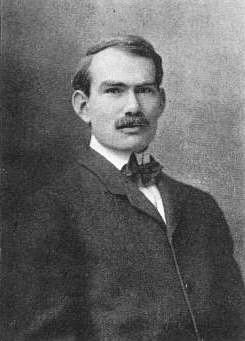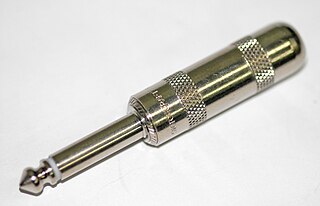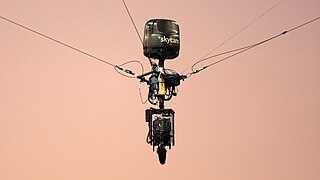
AM broadcasting is radio broadcasting using amplitude modulation (AM) transmissions. It was the first method developed for making audio radio transmissions, and is still used worldwide, primarily for medium wave transmissions, but also on the longwave and shortwave radio bands.

Wireless communication is the transfer of information (telecommunication) between two or more points without the use of an electrical conductor, optical fiber or other continuous guided medium for the transfer. The most common wireless technologies use radio waves. With radio waves, intended distances can be short, such as a few meters for Bluetooth or as far as millions of kilometers for deep-space radio communications. It encompasses various types of fixed, mobile, and portable applications, including two-way radios, cellular telephones, personal digital assistants (PDAs), and wireless networking. Other examples of applications of radio wireless technology include GPS units, garage door openers, wireless computer mouse, keyboards and headsets, headphones, radio receivers, satellite television, broadcast television and cordless telephones. Somewhat less common methods of achieving wireless communications involve other electromagnetic phenomena, such as light and magnetic or electric fields, or the use of sound.

Lee de Forest was an American inventor and a fundamentally important early pioneer in electronics. He invented the first practical electronic amplifier, the three-element "Audion" triode vacuum tube in 1906. This started the Electronic Age, and enabled the development of the electronic oscillator. These made radio broadcasting and long distance telephone lines possible, and led to the development of talking motion pictures, among countless other applications.

A phone connector, also known as phone jack, audio jack, headphone jack or jack plug, is a family of electrical connectors typically used for analog audio signals. A plug, the male connector, is inserted into the jack, the female connector.

In radio communications, a radio receiver, also known as a receiver, a wireless, or simply a radio, is an electronic device that receives radio waves and converts the information carried by them to a usable form. It is used with an antenna. The antenna intercepts radio waves and converts them to tiny alternating currents which are applied to the receiver, and the receiver extracts the desired information. The receiver uses electronic filters to separate the desired radio frequency signal from all the other signals picked up by the antenna, an electronic amplifier to increase the power of the signal for further processing, and finally recovers the desired information through demodulation.

John Charles Patrick Croghan Daly was an American journalist, host, radio and television personality, ABC News executive, TV anchor, and game show host, best known for his work on the CBS panel game show What's My Line?
Zenith Electronics, LLC, is an American research and development company that develops ATSC and digital rights management technologies. It is owned by the South Korean company LG Electronics. Zenith was previously an American brand of consumer electronics, a manufacturer of radio and television receivers and other consumer electronics, and was headquartered in Glenview, Illinois. After a series of layoffs, the consolidated headquarters moved to Lincolnshire, Illinois. For many years, their famous slogan was "The quality goes in before the name goes on". LG Electronics acquired a controlling share of Zenith in 1995; Zenith became a wholly owned subsidiary in 1999. Zenith was the inventor of subscription television and the modern remote control, and was the first to develop high-definition television (HDTV) in North America.

Stereophonic sound, or more commonly stereo, is a method of sound reproduction that recreates a multi-directional, 3-dimensional audible perspective. This is usually achieved by using two independent audio channels through a configuration of two loudspeakers in such a way as to create the impression of sound heard from various directions, as in natural hearing.
Shure Incorporated is an American audio products corporation. It was founded by Sidney N. Shure in Chicago, Illinois, in 1925 as a supplier of radio parts kits. The company became a consumer and professional audio-electronics manufacturer of microphones, wireless microphone systems, phonograph cartridges, discussion systems, mixers, and digital signal processing. The company also manufactures listening products, including headphones, high-end earphones, and personal monitor systems.

Charles David "Doc" Herrold was an American inventor and pioneer radio broadcaster, who began experimenting with audio radio transmissions in 1909. Beginning in 1912 he apparently became the first person to make entertainment broadcasts on a regular schedule, from his station in San Jose, California.

KNTV, branded as NBC Bay Area, is a television station licensed to San Jose, California, United States, serving as the NBC outlet for the San Francisco Bay Area. It is owned and operated by the network's NBC Owned Television Stations division alongside Telemundo outlet KSTS ; it is also sister to regional sports networks NBC Sports Bay Area and NBC Sports California. KNTV and KSTS share studios on North 1st Street in the North San Jose Innovation District; KNTV's transmitter is located on San Bruno Mountain.

The Circle 7 logo is an often-used television station logo in the United States. Designed in the early 1960s for the American Broadcasting Company's five owned-and-operated stations, the logo, or a version of it, is currently being used not only by several ABC stations and affiliates, but also by a number of television broadcasters around the world.

Skycam is a computer-controlled, stabilized, cable-suspended camera system. The system is maneuvered through three dimensions in the open space over a playing area of a stadium or arena by computer-controlled cable-drive system. It is responsible for bringing video game–like camera angles to television sports coverage. The camera package weighs less than 14 kilograms (31 lb) and can travel at 13 m/s (29 mph).

A wireless microphone, or cordless microphone, is a microphone without a physical cable connecting it directly to the sound recording or amplifying equipment with which it is associated. Also known as a radio microphone, it has a small, battery-powered radio transmitter in the microphone body, which transmits the audio signal from the microphone by radio waves to a nearby receiver unit, which recovers the audio. The other audio equipment is connected to the receiver unit by cable. In one type the transmitter is contained within the handheld microphone body. In another type the transmitter is contained within a separate unit called a "bodypack", usually clipped to the user's belt or concealed under their clothes. The bodypack is connected by wire to a "lavalier microphone" or "lav", a headset or earset microphone, or another wired microphone. Most bodypack designs also support a wired instrument connection. Wireless microphones are widely used in the entertainment industry, television broadcasting, and public speaking to allow public speakers, interviewers, performers, and entertainers to move about freely while using a microphone without requiring a cable attached to the microphone.
The timeline of radio lists within the history of radio, the technology and events that produced instruments that use radio waves and activities that people undertook. Later, the history is dominated by programming and contents, which is closer to general history.

Anthony F. Verna was a producer of television sports and entertainment blockbusters.
Broadcasting in the United States began with experiments with wireless transmission during the middle of the 19th century, with varying degrees of success. These transmissions were initially by radio hobbyists fascinated with the technology. Once techniques were perfected, radio became a necessity for military and commercial users alike. Eventually, broadcasting would come to have a major impact throughout the country. Growth divided television broadcasting into several genres, such as fiction, news, sports, and reality television. Cable television provided more channels, especially for entertainment. By the late 20th century radio (sound) broadcasting had similarly divided, with stations specializing in a particular musical genre, or news or sports.
The following timeline tables list the discoveries and inventions in the history of electrical and electronic engineering.

The Schaffer–Vega diversity system (SVDS) was a wireless guitar system developed in 1975–76, engineered and prototyped by Ken Schaffer in New York City, and manufactured by the Vega Corporation, El Monte, California. A handheld microphone version was introduced in 1977.
Clear-Com, also known as ClearCom, is a manufacturer of electronic intercom products, widely used to enable stage management and crew communications in theatre, filmmaking, video and television production, concerts, professional sports competitions, special events and audiovisual presentations. Providing the first portable party-line intercom system to feature simple XLR cable connections, Clear-Com soon became an accepted industry standard. The National Academy of Television Arts & Sciences honored the company with a Technology and Engineering Emmy Award in 2010.













